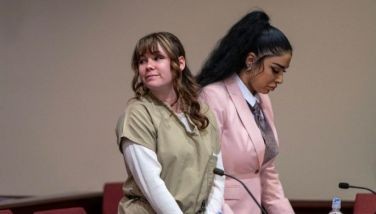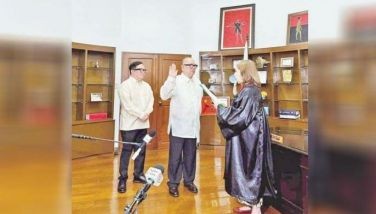‘It feels like you never want to go home!’
Ever wondered what it feels like to live in space for six months?
“It feels like you never want to come home.†That’s how Dr. Catherine Coleman, a NASA astronaut who has logged more than 4,330 hours in space aboard the Space Shuttle Columbia and the International Space Station, described her experience during a 30-minute interview held in Los Angeles recently. “If I could bring my family, there is just no reason to ever come home. Some of it is inconvenient but it is incredibly delightful and magical. It’s like living the life of Peter Pan — I get to fly everywhere and I love it!â€
“I got to spacewalk, it’s the most extraordinary thing that I got to do,†added Dr. Michael J. Massimino, also a veteran NASA astronaut who has logged a comparably fewer 571 hours in space but unlike Dr. Coleman has actually done a total of 30 hours and four minutes of spacewalk. “The thing I remember most about space is the view from the spacewalk. When I was inside the space shuttle and looking through the window you can see the earth and the stars and it’s very beautiful but it’s like looking at an aquarium, sort of. When you go outside and spacewalk, you become a scuba diver. You become a real space man now!â€
“You have this amazing view. You can see the earth at its entirety. You can see the curvature and to me it’s like a view into heaven. The only way I could describe it is our planet looks like a paradise. It is so beautiful!â€
It’s not everyday that one gets to spend a half hour with real-life NASA astronauts so this writer considers himself quite fortunate to have had the opportunity to just do that. The Philippine STAR was among select international publications invited to the junket of Warner Bros. Pictures’ latest film Gravity and this writer had the rare chance to join a select group of journalists in the exclusive interview as part of the publicity campaign for visionary filmmaker Alfonso Cuaron’s movie that’s already generating superlative buzz for its groundbreaking space photography and Sandra Bullock’s commanding performance.
Dr. Massimino and Dr. Coleman were on hand to provide answers to the more scientific and technical questions that journalists have about the film. They were surprisingly comfortable with the media. They were exact opposites of the stereotypical shy and socially challenged scientists. They were very relaxed; they cracked jokes, opened up about their most personal experiences and like every one who has watched Gravity were quite effusive with their praise of the movie.
“I think that this movie — we are not going to have that kind of day, hopefully, in space because we are very careful about these things that we do up there — but that movie brings you to space. It’s as if you are inside the Cupola looking out and being there with us,†Dr. Coleman remarked. “It’s amazing, this movie. The visual part of it is just astounding.â€
Did you know that inside the space station are modules called Cupola? These modules allow the astronauts to have a nearly unobstructed view of what’s outside the space station without venturing out to space.
Did you know that the whole space station is upside down?
Did you know that in outer space, the earth does a full rotation every 90 minutes? There’s light for 45 minutes and there’s complete darkness for the other 45 minutes. (Trivia: The running time of Gravity is 90 minutes, can you tell me why?)
These are some of the interesting things this writer learned from our interview and below is a sampling of the questions we asked the astronauts where we learned more about their lives as this planet’s foremost scientists:
Space is polluted and there’s real danger out there. Does that message come across in a positive way in the movie?
Dr. Massimino: I think it comes off in an extreme way, in a sensationalized way. It’s something we think about. There’s more debris, some of it are man-made, you know, satellite parts that have been scattered, some of it are natural rocks (meteorites) floating around the planet. These are the things we think about and worry about and we practice a debris strike, we practice what we would be doing in those types of emergencies.
Dr. Coleman: These are real risks and we are dealing with them in a real way. It’s definitely a problem and there are a lot of people addressing it around the world. In Colorado, they track every bit of space debris. The perspective that you need is that when you think of the space shuttle that’s maybe like the size of an airplane but the space station is a giant space complex. It’s huge — like a giant building so you cannot just move it in a moment’s notice. It takes a lot of calculating and doing things. There are times that we find this out too late and there are shelters in place in the Soyuz capsules (Russian space crafts.) When it happens, they call our sweethearts and families at home to make sure that they get the news before the media gets the news.
Gravity portrays the emotional part of being in space. How emotionally different is it up there for you?
Dr. Massimino: It’s very emotional! My first reaction was not to look at it. It was like, ‘this is too beautiful!’ The thought that went through my mind was ‘God did not intend for people to see this, you shouldn’t be looking.’ I actually turned my head and then in about two seconds I looked again and it was a perfect sight. And, as I started looking at how beautiful it was, I started to tear up. I got a bit emotional. It was the most emotional I ever got. The third time I looked, I thought about heaven. This should be the view from heaven. If you are in heaven and you can look down on our planet, this is what you would be seeing.’ The sheer beauty around me — it was not for me, it was not for the intellectual, it was just, wow!
What have you learned from being an astronaut?
Dr. Coleman: It’s a little hard for me to keep my stuff together and it’s actually really essential in space where it’s all going to float away and you might never find it. I found somebody’s pocketknife that actually belonged to her grandmother that’s been missing for three years. I actually had to learn to be very disciplined about getting stuff out, putting it away, starting, finishing — because I am very scattered on the ground but I am very together in space and I am very proud of that.
Dr. Massimino: One thing I learned is that working together is always the way to solve a problem. The movie kind of shows that: When something goes wrong or you have a problem you can work together.
How is it like when you are about to fly to space?
Dr. Massimino: One of the nicest things from flying out of the Kennedy Space Center on the shuttle back then was that your family was part of it. My wife and kids flew to the Kennedy Space Center. My mom was there. It’s kind of a special time. That week, when you are in quarantine, they come to visit you and you get to spend quality time before you go and then, you know, lurking in the background that you don’t really get to talk about is the possibility of something going bad on launch day or while on mission. We all know it’s a risky thing and that can be a bit emotional. The goodbye that you make with your family right before is a very emotional goodbye. You try to make sure that everything’s taken care of if something does happen.
Dr. Coleman: It’s a pretty emotional thing. I think all of us are different the way we prepare our kids. When I started training, people started talking about it to my family and to my kid. And so I said, ‘Listen, I am going to be training for the space station,’ he was seven, ‘I’m not going to go when you are in first grade. I am not going to go when you are in second grade. I am not going to go when you are in third grade but when you are in fourth grade, I am going to go and live on the space station like most of the time that you are in fourth grade and I’ll be home right about the time when you get out of school.’ But on a lighter note, on my first mission, we actually delayed seven times over 30 days because it was a shuttle launching during the hurricane season from Florida. We had one mechanical problem and just delay after delay after delay. We went from having a busload of family to like a family mini-van. I actually said goodbye seven times to my husband and by the end he was, like, ‘Go already!’
What are your thoughts on space tourism?
Dr. Coleman: I think the more people that get to go to space the better. They should be trained to be safe; to operate emergency equipment and to make sure they understand what they need to do to be safe for them and to be safe for the rest of the crew. And, they have to have a good attitude about being there to work or on the important work that we do.
When we wrapped up the interview, all the journalists, including yours truly, flocked to the astronauts to have our pictures taken with them.
Going to space may remain just a dream to many of us but that day spent with real NASA astronauts (and the picture to get with it) more than make up for it. And, if they say that watching Gravity is the closest thing to being in space, then I have been to space — technically. And I plan to go back.
Gravity is now showing in theaters nationwide.
- Latest
- Trending
































